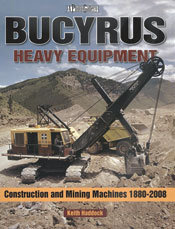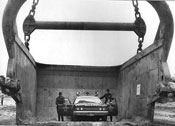 
| Bucyrus Heavy Equipment By Keith Haddock In the beginning, there was Bucyrus. The story of the 128-year-old manufacturing company is about as colossal as the giant excavating machines it produces. Many have long gone to the scrappers or forgotten bone yards, but some Bucyrus rigs are still hard at work, mining the world’s minerals. Veteran equipment historian and civil engineer Keith Haddock scoops away the overburden to reveal one of the construction and mining industry’s most awe-inspiring companies in his latest book. The 222-page, soft-cover guide takes the reader on an adventure through the most ambitious projects on the planet, with 450 black-and-white photos detailing every type of machine that Bucyrus has made. The story goes far deeper than his 2002 book, The Earthmover Encyclopedia, and includes model schedules, factory locations and a handy glossary of technical terms. Haddock walks us through the small steps it took for South Milwaukee, Wis.-based Bucyrus to become the stuff of industry lore. It built niche machines so productive, robust and reliable that it nearly worked itself into extinction. Like all good companies, Bucyrus reinvented itself to stay alive. Today, Bucyrus International Inc. is still at it, selling handfuls of giant earthmovers worth more than $1.6 billion last year. In its effort to dominate the dirt pile, Bucyrus began its journey building a railroad steam shovel in Bucyrus, Ohio, and soon after moved to new digs in Wisconsin, as it was already back then becoming too big for its britches. By 1901, it offered a full line of steam shovels ranging from 12 tons to 95 tons. Those early machines mined the Mesabi Iron Range and dug the Panama Canal. Enter the Erie Steam Shovel Co., which Bucyrus picked up in 1927 to become Bucyrus-Erie and grab the “universal” excavator market. Those quick-change machines were not only significant in speeding up construction, they also became the forebears of the modern crawler crane. Speaking of cranes, Bucyrus produced one of the first American-made tower cranes, the Mark I-50, in 1960, and it built some of the earliest hydraulic truck cranes. It also was an important supplier of drills, backhoe-loaders, hydraulic excavators, trenchers, dozer blades and tow-scrapers. Over the years, Bucyrus became bigger than life, competing with Marion Power Shovel Co., which it eventually bought in 1997. In the 1960s, Marion built “The Captain,” a Model 6360 super stripper with a 180-cu-yd dipper. Bucyrus responded with “Big Muskie,” a 22-story-tall, walking dragline with a 220-cu-yd bucket. They were modern-day, mechanical dinosaurs. The Marion machine tipped the scales at 15,000 tons and still holds the title of the heaviest machine to roam the Earth. You could say it even had a role in walking on the moon: A transporter based on its crawler tracks hauled the Apollo rockets and still takes the Space Shuttle to the launching pad. |
Book Reviews:
Book Reviews: 11/26/2008

Post a comment to this article
Report Abusive Comment